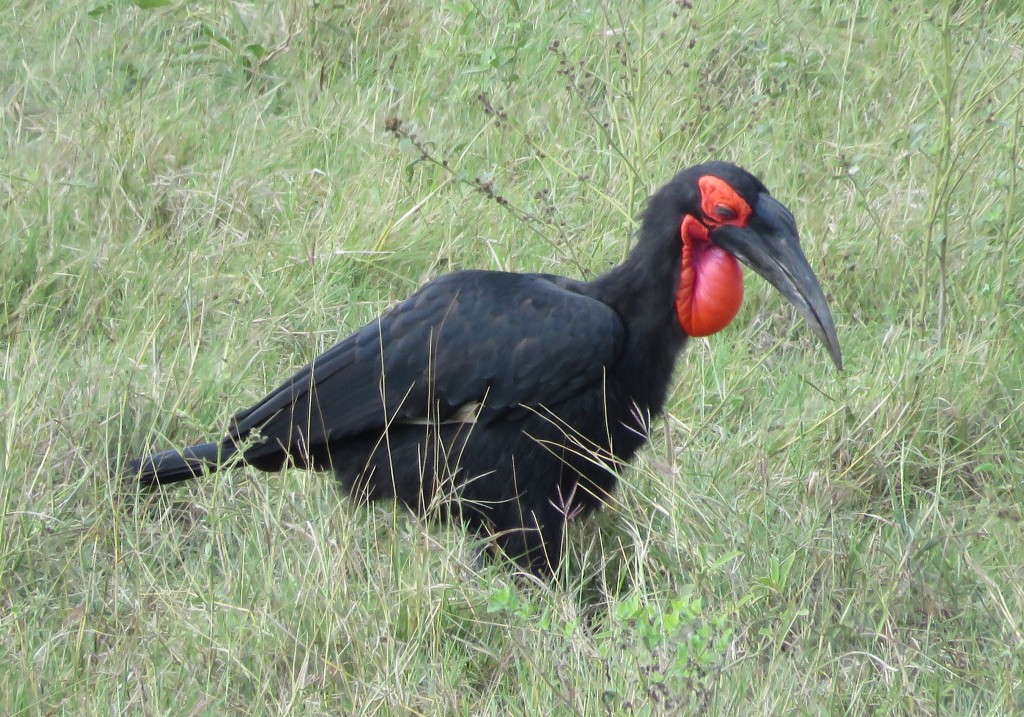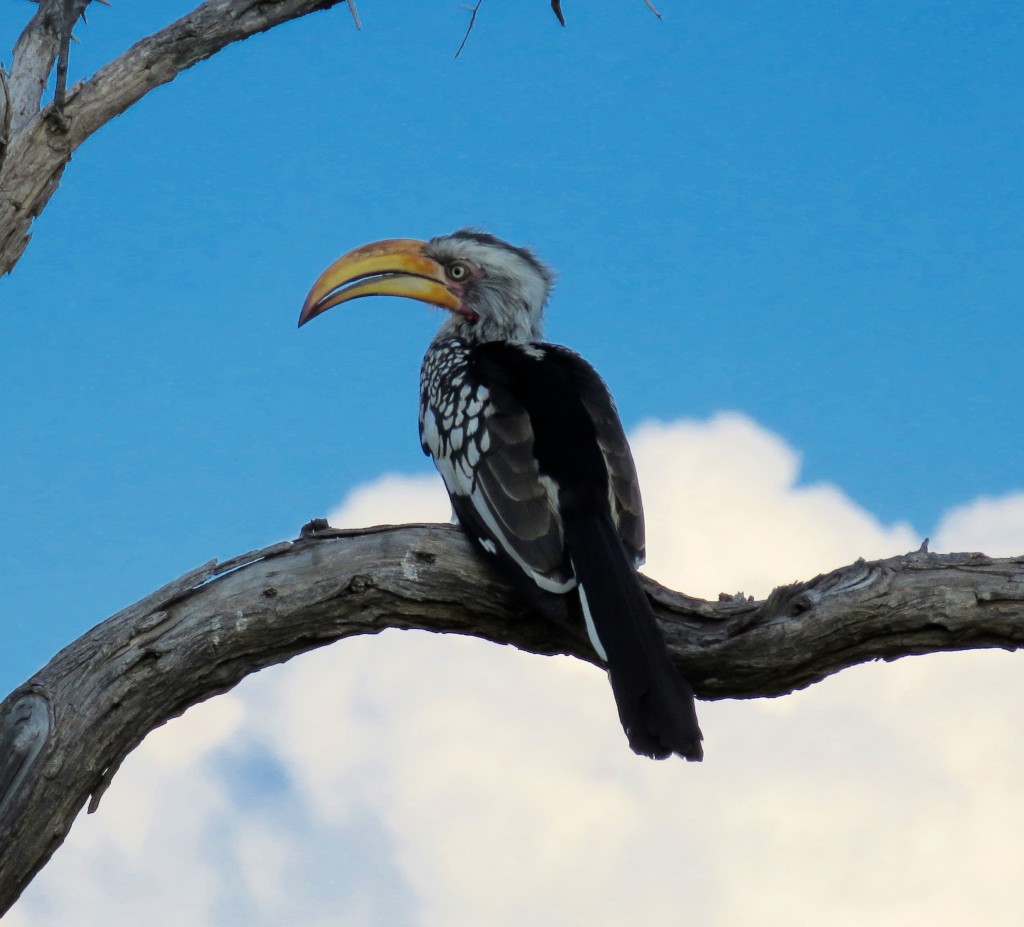The Zambezian Baikiaea Woodlands Ecoregion (AT0726) extends over a large area of Angola, Namibia, Botswana, Zambia, and Zimbabwe. The ecoregion is dominated by Baikiaea plurijuga, commonly known as Zambezian teak, although it is not related to the true teaks of southeast Asia. See some photos of this impressive tree, which defines the ecoregion, at the link above.
I’m writing this blog on the ecoregion and its birds, sitting in Hwange Safari Lodge, on the edge of Hwange National Park in Zimbabwe. Three different ecoregions cover this enormous park, the largest in the country, but the most dominant is the Zambezian Baikiaea Woodlands. I’m a few km from where Cecil the lion recently expired, victim to the controversial shot that resounded on social and traditional media around the world. Strange that none of the articles or Facebooks posts mentioned in which ecoregion he met his end?! From a birder’s perspective, I’m thinking about whether or not trophy hunting is a crazy and unsupportable notion “for the birds”, or whether really, it is for the birds, and favourable to conservation?
I can’t answer the question of whether trophy hunting or hunting is intrinsically good or bad. The answer is rooted in your own moral, ethical, and philosophical world view, and is neither right not wrong. Nor do I want to dwell on the rights and wrongs in the case of Cecil, a case presently before the Zimbabwean courts, but I can say that most of the information that has widely appeared around the world was simply false. The question of whether or not trophy hunting is good for conservation should however be amenable to a logical facts-driven analysis – yes or no. The answer, as it so often is, seems to be… yes, no, or maybe, it depends.
There are cases where trophy hunting is certainly positive for conservation – where it generates critical revenues for conservation causes or for communities which are stewards of important habitats. There will be also some cases where it will be negative for conservation, if it is uncontrolled or targeting inappropriate species.
I spent a few days around Hwange National Park talking to safari hunting guides, to communities, and to the staff of the Park. It seems pretty clear that in the large communally-managed hunting reserves that border Hwange National Park, trophy hunting has a real positive conservation value. These areas are supported by Zimbabwe’s famous CAMPFIRE programme, one of Africa’s oldest efforts to support communities to manage their own natural resources, including management of sport hunting. Under the CAMPFIRE program, 55% of trophy hunting fees are deposited directly in a community-controlled bank account, 25% support local councils, and the remainder of the fees help pay for the technical support to the communities. In successful CAMPFIRE communities, and admittedly not all of them are successful, the trophy hunting revenues are very important. They can be the primary source of revenues for local councils and provide important funds for schools, health posts, or for other community priorities. Small amounts of funds can go a long way in impoverished rural communities. It is clear that in these hunting reserves, the habitat is protected. They form important buffers to the Park and seem to have fewer poaching problems. Communities will protect habitats which generate money for them – its really that simple.
Hwange National Park also has hunting areas in its buffer zone which fall directly under the management of the parks agency. These generate significant funds which are critical for ZimParks, which receives zero funding from the Government, apart from staff salaries. Approximately 60% of all the non-salary revenue of ZimParks country-wide is generated from trophy hunting revenues, almost all of it around Hwange NP. So, at least for the Land of Cecil, the answer is unequivocal – trophy hunting is positive for conservation. If it were ever actually stopped in Zimbabwe, it would be calamitous for the entire park system of the country and most likely the communally managed hunting reserves, buffers to Hwange, would become degraded once communities lose interest in protecting them.
The only near endemic bird species to this ecoregion is Bradfield’s Hornbill, which I haven’t managed to see yet. Below are a couple of photos of other hornbills, photographed April 10, 2015 in Hwange.


Awesome photos; stupendous birds. I’m glad you’ve “gone public” on the trophy hunting issue, not an easy thing to do, and those that know you, know your incredible committment to saving ecoregions. Trophy huntin is not an issue that is easy to understand as it flies in the face of immediate logic, and yet when you are on the ground in the country, you can weigh it against the alternative…enormous wildlife losses to poaching which is plaguing all of Africa and decimating the wildlife, especially anything with a horn or edible body part (that is virtually everything, all birds, all animals), I’ve heard only the crocs and hippos are escaping our appetites and so their populations are increasing. A scary thought.
Thank you Douglas for your Zambezian ecoregion story. I’m glad you are speaking about Cecil the Lion that highlights how the majority of human action around the world is revenue based. Protecting the park so trophy hunters will be successful and generate local revenue is the only reality for those people you talked with. We need to hear their perspective, so thank you.
I was intrigued about 3 of the birds you mentioned in the ecoregion; black-cheeked lovebird, bateleur and Pel’s fishing owl. It was fascinating to read further about the owl; in the top 5 of largest owls in the world, of gorgeous ginger colour and adapted to fishing! Cool. Now I know bateleur is a French word for “street performer” – one who is a tight rope walker. The bateleur is an eagle that rocks back and forth in flight as if to gain its balance like a tight rope walker. Very Cool. And the black-cheeked lovebird is a sorry tale of population loss by the bird pet sale industry. In 1983 my husband and I purchased from a Vancouver pet store an Alexandrine parakeet (probably illegally captured from the Andaman Islands). Today these birds are suffering the same population loss as the black-cheeked lovebird. He was such a beautiful bird but with an intolerably loud screech and so within a year I gave him to the Andaman Parrot rehabilitation lady to care for. Those were irrational days and I still feel regret.
But thanks again for sharing the beauty and wonder of worlds I will not get to experience in person, but I can learn from afar as I sit in my computer desk chair.
Great photos, and once again, great info about the issue of Trophy hunting: certainly a double-edged sword
i enjoyed reading this blog post, learned quite a few interesting things.